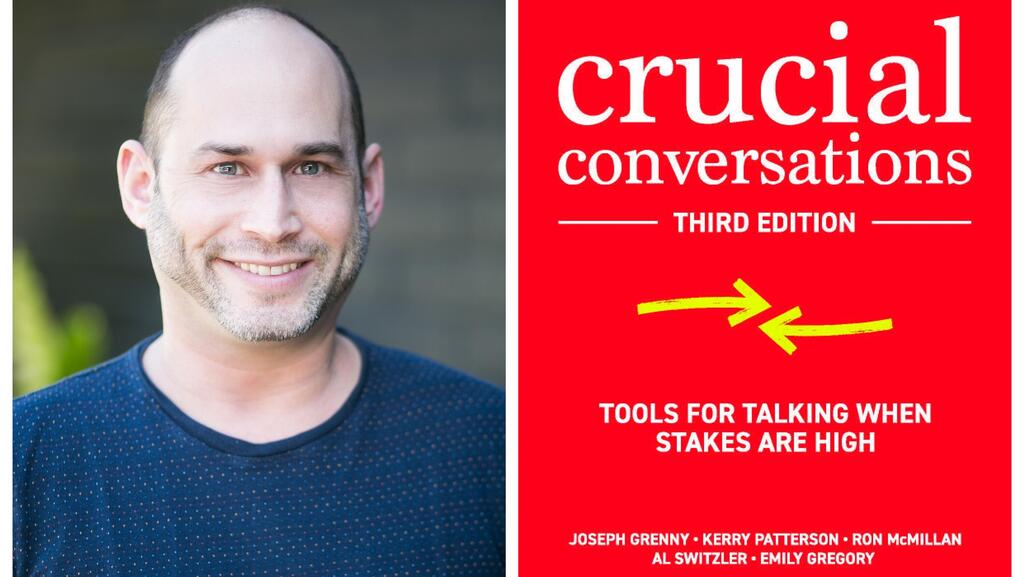
BiblioTech
CTech's Book Review: Spotting the significance of crucial conversations
Matan Efrima, CPO at Tetavi, shares insights after reading “Crucial Conversations: Tools for Talking When Stakes Are High" by Kerry Patterson, Joseph Grenny, Ron McMillan, and Al Switzler.
Matan Efrima is the CPO at Tetavi, a volumetric video capture system. He has joined CTech to share a review of “Crucial Conversations: Tools for Talking When Stakes Are High" by Kerry Patterson, Joseph Grenny, Ron McMillan, and Al Switzler.
Title: “Crucial Conversations: Tools for Talking When Stakes Are High"
Author: Kerry Patterson, Joseph Grenny, Ron McMillan, and Al Switzler.
Format: Book
Where: Home
Summary:
“At the heart of almost all chronic problems in our organizations, our teams, and our relationships lie crucial conversations – ones that we’re either not holding or not holding well.” This is the main paradigm of the book titled “Crucial Conversations” by Kerry Patterson, Joseph Grenny, Ron McMillan, and Al Switzler.
According to the authors, Crucial conversations are these critical moments in life where you face a combination of opposing opinions, high stakes, and strong emotions. Unfortunately, these are also the moments where we are usually at our worst: Through many years of evolution, we were programmed to react poorly to these stressful situations, using fight or flight mechanisms, instead of using our logic and emotional intelligence to handle the delicate situation well.
We have all been there: critiquing a colleague’s work, asking in-laws to quit interfering, giving the boss feedback about her behavior, ending a relationship, giving an unfavorable performance review, asking a friend to repay a loan – all of these are examples of potentially crucial conversations.
Throughout the book, using a combination of theory, research results, and made-up examples, the authors provide a toolbox for successful management of crucial conversations, allowing the readers to deal well with these critical moments and develop the key skills of talking, listening, and working together.
Important Themes:
- Identifying a safety risk:
Tools for identifying a crucial conversation situation and especially identifying where there is a risk to a safe dialogue, critical for a healthy and fruitful conversation. Focusing on behavioral patterns such as silence (masking, avoidance, and withdrawal) or violence (controlling, labeling, attacking) caused by such unsafe dialogue, and specifically on identifying one’s own style of stress. - Making it safe:
Once the conversation is derailed due to an introduction of a safety risk, be it a risk to the mutual purpose or mutual respect between the participants, the reader is introduced with different techniques to return the safety of the conversation. - Actions, negative emotions, and stories:
The authors call upon the reader to identify when he is scared or hurt within the dialogue and take ownership of his emotions and the actions derived from them. They claim that the emotions can be traced back to a story we told ourselves based on the facts collected in the situation. By backtracking to the story and telling ourselves a different story (based on the same facts), looking at the situation from a different perspective – one can avoid the bad feelings and the actions they cause. - Sharing the knowledge:
After setting the stage for a successful crucial conversation by removing the hurdles of risks to safety for all participants, the book turns to suggest methods for the actual conduction of the conversation – allowing all the participants to share their knowledge, facts, and opinions in a way that maintains safety while encouraging meaningful dialogue. - Crucial conversations outcome:
Finally, after achieving a safe environment and conducting a successful dialogue where all participants can openly share their knowledge, the book offers several ways to effectively transform this discussion into a decision and the decision into an action plan.
What I’ve Learned:
Usually, self-improvement literature is not exactly my cup of tea, but “Crucial Conversations” struck a chord in me. As a manager of people, products, and processes, one of the most powerful tools in my arsenal, and probably the most crucial one, is conversations.
Our business environment is multidisciplinary by nature - where each employee contributes his unique expertise, experience, and point of view in any conversation, bringing multiple voices and opinions to each discussion. It is also full of passionate people, mandatory for achieving the goals that sometimes look impossible to any outside viewer. And finally, in the ongoing journey towards success, high stake situations are almost a daily routine. In this environment, many of our conversations are crucial conversations.
Related articles:
Reading this book gave me the time and space to consider the way that I deal with crucial conversations. It helped me to better prepare for them and identify them in real-time. It allowed me to put some order and structure into tools I used instinctively, pinpoint problematic behaviors I later worked to root out, and gave me confidence in my ability to successfully conduct such crucial and delicate moments.
Finally, as I believe that conversations are the foundation of any relationship - with friends, families, and loved ones - I believe it has also improved the way I conduct myself as a human being and helped me become a better person.
Who Should Read This Book:
Since dialogues are such a major cornerstone in any relationship, relevant for everyone, for me it is more a question of when should one read the book and not who should read it. When you have the self-confidence to look inwards, when you have the eagerness to learn, and when you have the emotional availability to change, this is the time.